
The Ultimate Guide to Vehicle Maintenance Tracking Apps: Transform Your Car Care Strategy
Breaking Free from Traditional Maintenance Management

Remember those old paper logbooks stuffed in your glove compartment? For years, that was how we tracked vehicle maintenance - waiting until something broke before taking action. This approach not only led to forgotten service appointments but often resulted in expensive repairs that could have been prevented. Today, vehicle maintenance tracking apps are changing how we care for our cars by helping owners stay ahead of problems and take control of maintenance schedules.
Why Paper Logbooks Are Becoming Obsolete
Picture trying to sell your car and prove its maintenance history using scattered paper records. With a vehicle maintenance tracking app, you can instantly show potential buyers a complete digital service history at the tap of a screen. This shift to digital tools makes particular sense for younger vehicle owners - a DMEautomotive study found that 59% of auto service customers under 35 prefer communicating through mobile apps. Beyond just storing records, these apps provide features that paper logs simply can’t match.
The Benefits of Embracing Digital Vehicle Maintenance
Modern maintenance tracking apps serve as a central hub for managing all aspects of vehicle care, from basic oil changes to major repairs. Instead of trying to remember when services are due, you get automatic reminders that help prevent small issues from becoming costly problems. You can upload photos of receipts and service documents to build a detailed digital history that’s invaluable for warranty claims and resale value. For example, fleet managers who switched to digital tracking report maintenance cost reductions of up to 40% - real savings that come from catching problems early and maintaining consistent service schedules.
Overcoming the Challenges of Digital Adoption
While switching from paper to digital tracking might seem daunting at first, today’s apps are designed to be simple and user-friendly. Most feature clean, intuitive dashboards that clearly show upcoming maintenance needs and vehicle health metrics. Having maintenance records accessible anywhere provides peace of mind and helps owners make smarter decisions about vehicle care. This move to digital maintenance tracking isn’t just about convenience - it’s about taking better care of our vehicles through more organized, proactive maintenance that saves money and extends vehicle life.
Essential Features That Define Modern Vehicle Care

Vehicle maintenance apps have evolved far beyond basic digital logs. They now offer powerful tools that give car owners unprecedented control over maintaining their vehicles. Thanks to mobile technology, scheduling maintenance, tracking repairs, and monitoring vehicle health has become simpler and more effective than ever before.
Core Functionalities for Effective Tracking
A good vehicle maintenance app needs several key features to help owners properly manage their vehicles and stay on top of regular maintenance.
- Automated Service Reminders: These apps eliminate the need for manual reminders by sending notifications when it’s time for oil changes, tire rotations, and other routine maintenance. This helps catch small issues before they become expensive problems.
- Digital Maintenance Logs: All service records are stored securely in one place and can be accessed anytime. This organized history is especially valuable when selling a vehicle since you can show potential buyers detailed maintenance records.
- Expense Tracking: Monitor and categorize all maintenance costs to understand spending patterns and plan future maintenance budgets more effectively.
While these basic features offer significant benefits, modern apps include even more capabilities to help owners care for their vehicles.
Advanced Features for Enhanced Vehicle Management
Today’s maintenance apps include sophisticated features that help owners better understand their vehicles and prevent problems proactively.
- Real-Time Diagnostics: Many apps can connect to your vehicle’s onboard diagnostic system to provide instant alerts about potential issues. Getting early warnings about problems lets you address them before they lead to breakdowns or expensive repairs.
- Multi-Vehicle Management: For families or businesses with multiple vehicles, these apps can track maintenance schedules and expenses across an entire fleet from one central dashboard. This makes it much easier to coordinate service appointments and track costs.
- Integration with Service Providers: Book appointments and automatically update service records by connecting directly with repair shops through the app. This saves time and reduces paperwork while keeping all maintenance information organized.
Using a comprehensive app like the Auto Service Logger makes vehicle maintenance more organized and effective. These digital tools give owners the information they need to make smart decisions about vehicle care and keep their cars running well for years to come. For anyone wanting to properly maintain their vehicle and avoid costly repairs, using a maintenance tracking app has become an essential part of responsible car ownership.
Harnessing AI for Smarter Maintenance Decisions

Modern vehicle maintenance tracking apps now incorporate artificial intelligence capabilities that fundamentally change how we care for our vehicles. Rather than just logging past service records, these AI-enabled systems can predict future maintenance needs by analyzing patterns and data. This shift from reactive to proactive maintenance helps prevent unexpected breakdowns while extending vehicle life.
How AI Predicts Maintenance Needs
The AI systems in maintenance apps process multiple data streams including service history, driving patterns, and real-time vehicle diagnostics. For instance, the app may detect a gradual decrease in fuel efficiency over several months and, by examining this trend alongside factors like mileage and driving style, determine that the fuel filter needs replacement before performance suffers. This ability to spot emerging issues represents a major advancement over traditional maintenance approaches that only respond after problems occur.
Benefits of AI-Driven Maintenance
The impact of AI-powered maintenance tracking is clear in the real-world results. Major fleet operators report maintenance cost savings of up to 30% after implementing AI-based systems. These savings come from catching potential issues early when repairs are simpler and less expensive. AI also helps schedule maintenance at optimal times to reduce vehicle downtime. This smarter scheduling not only reduces costs but also helps vehicles stay in service longer.
Choosing a Vehicle Maintenance Tracking App with AI
When evaluating maintenance tracking apps, focus on those with strong AI capabilities. Apps like Auto Service Logger offer predictive alerts, custom recommendations, and integration with vehicle diagnostics. Keep in mind that AI systems need quality data to make accurate predictions. Regular logging of maintenance activities and vehicle usage helps the AI learn and provide better insights. By selecting an app with robust AI features and using it consistently, you can shift from fixing problems after they happen to preventing them before they start. This proactive approach reduces stress and lets you spend more time enjoying your vehicle rather than repairing it.
Maximizing Vehicle Performance Through Telematics

While basic vehicle maintenance apps help track service records, adding telematics capabilities takes monitoring and optimization to new heights. By combining real-time data collection with maintenance tracking, these systems give fleet managers and vehicle owners deep insights into how their vehicles are actually performing on the road. This allows for smarter decisions about maintenance, fuel efficiency, and driver safety.
Understanding the Power of Telematics Integration
At its core, telematics involves installing devices that gather data about vehicle location, speed, fuel usage, engine performance, and driving patterns. This information flows into a central system for analysis to improve operations. For instance, when integrated with maintenance tracking apps, telematics automatically records key metrics like mileage and fuel consumption without manual data entry. The system can even capture engine diagnostic codes in real-time, creating detailed and accurate maintenance histories.
How Real-Time Monitoring Prevents Costly Breakdowns
One of the biggest advantages of telematics is catching potential issues before they lead to major repairs. The system continuously tracks critical indicators such as engine temperature, oil pressure, and tire conditions, sending immediate alerts when problems start developing. This early warning system helps fleet managers and drivers address maintenance needs proactively rather than reactively. If a breakdown does occur, the location tracking feature enables quick dispatch of roadside assistance to get vehicles back on the road.
Optimizing Fleet Operations With Telematics Data
For companies managing vehicle fleets, telematics brings significant operational benefits when combined with maintenance tracking. The location data helps identify more efficient routes to reduce fuel costs and time spent on the road. The system also monitors driving behaviors like rapid acceleration or hard braking that can impact safety and vehicle wear. Managers can use this information to create targeted driver training programs that improve safety records and reduce insurance expenses. By viewing maintenance, location, and driver data in one system, businesses gain a complete picture of their fleet’s performance.
Implementing Telematics: A Step-by-Step Guide
Adding telematics to your maintenance strategy can be straightforward with the right approach. Begin by determining your main priorities - whether that’s preventing breakdowns, improving driver safety, or reducing fuel costs. Then evaluate maintenance tracking apps that seamlessly incorporate telematics features. Tools like Auto Service Logger provide a single dashboard for managing maintenance records alongside real-time vehicle data. Look for customizable reporting options that let you analyze the metrics most relevant to your goals. With the right setup, you can maximize the value of your telematics investment while effectively maintaining your vehicles.
Building a Sustainable Fleet Through Smart Technology
A vehicle maintenance tracking app combined with telematics and AI helps organizations build more environmentally responsible fleets while improving operations. By tracking key performance metrics and maintenance needs, these tools support both traditional and electric vehicle fleets in reducing their environmental impact.
Reducing Emissions Through Smart Route Planning and Preventative Maintenance
For conventional vehicles, careful route planning directly impacts fuel consumption and emissions. Modern vehicle maintenance apps analyze traffic conditions, road closures, and driver behavior in real-time to find the most fuel-efficient routes. Consistent preventative maintenance, easily managed through a tracking app, also plays a vital role. For instance, simply monitoring tire pressure - a basic but essential task tracked by these apps - significantly improves fuel economy and reduces unnecessary emissions.
Optimizing EV Fleets for Sustainability
Electric vehicle fleets present unique opportunities for sustainable management. A vehicle maintenance tracking app becomes essential for maximizing battery performance and lifespan. These tools monitor battery health, track charging patterns, and help schedule charging during off-peak hours. This detailed battery management ensures optimal performance while extending battery life. The apps also help drivers locate charging stations powered by renewable energy sources, further reducing the fleet’s environmental footprint.
Tracking Environmental Metrics for Continuous Improvement
Measuring progress is key to any environmental initiative. Vehicle maintenance tracking apps give fleet managers clear visibility into important metrics like fuel usage, emissions output, and electricity consumption. This data helps organizations understand the real impact of their sustainability efforts and spot areas that need attention. For example, if the data shows excessive idling patterns, managers can implement specific driver training to address this issue, leading to concrete reductions in fuel waste and emissions.
Balancing Sustainability With Operational Efficiency
While environmental goals are important, they must work alongside operational needs. Tools like Auto Service Logger help achieve both aims. By coordinating maintenance schedules, identifying potential problems early, and making the best use of resources, these apps help keep vehicles running smoothly with minimal downtime. This creates a positive cycle where improved efficiency frees up resources for additional sustainability projects. The result is a well-maintained fleet that meets both environmental and business goals without sacrificing either.
Selecting and Implementing Your Ideal Tracking Solution
Choosing and setting up a vehicle maintenance tracking system requires thoughtful planning to ensure it truly serves your needs. Just like regular car maintenance keeps your vehicle running smoothly, having the right tracking solution helps you stay on top of essential upkeep without hassle.
Defining Your Needs and Requirements
Start by getting clear on exactly what you need from a tracking system. If you’re a single vehicle owner, you might simply want an easy way to log oil changes and tire rotations. Fleet managers, on the other hand, often need robust solutions that can handle multiple vehicles, complex maintenance schedules, and data reporting. Consider your technical comfort level too - if you or your team aren’t especially tech-savvy, prioritize apps with simple, user-friendly interfaces. Taking time for this assessment helps narrow down options to those that best match your situation.
Evaluating and Comparing Available Platforms
Once you know what you’re looking for, create a simple comparison of different apps to find the right fit. A basic feature comparison table can help visualize the differences:
| Feature | App A | App B | App C |
|---|---|---|---|
| Automated Reminders | Yes | Yes | No |
| Expense Tracking | Yes | No | Yes |
| Multi-Vehicle Support | No | Yes | Yes |
| Telematics Integration | Partial | Yes | No |
| AI-Powered Predictions | No | No | Yes |
Beyond features, look into user reviews and ratings to understand real-world experiences. Pay attention to things like how responsive the customer support is, what security measures are in place, and how often the app gets updated with improvements.
Ensuring Smooth Implementation and User Adoption
Picking your app is just the start - getting everyone on board and using it effectively takes some work too. For fleet operations, this means properly training your team and fitting the new system into existing work processes. Clear communication about why you’re making the change and ongoing support help smooth the transition. Regular check-ins to address any issues and gather feedback ensure you get the most value from your tracking solution.
For individual users, success often comes down to building good habits. Set reminders to log maintenance work when it happens and review your tracking data regularly. Think of it like checking your oil - a quick routine that prevents bigger problems later.
Ready to take better care of your vehicles? Auto Service Logger offers all the tools you need to track maintenance, manage costs, and keep your vehicles running right. Start your free trial today!